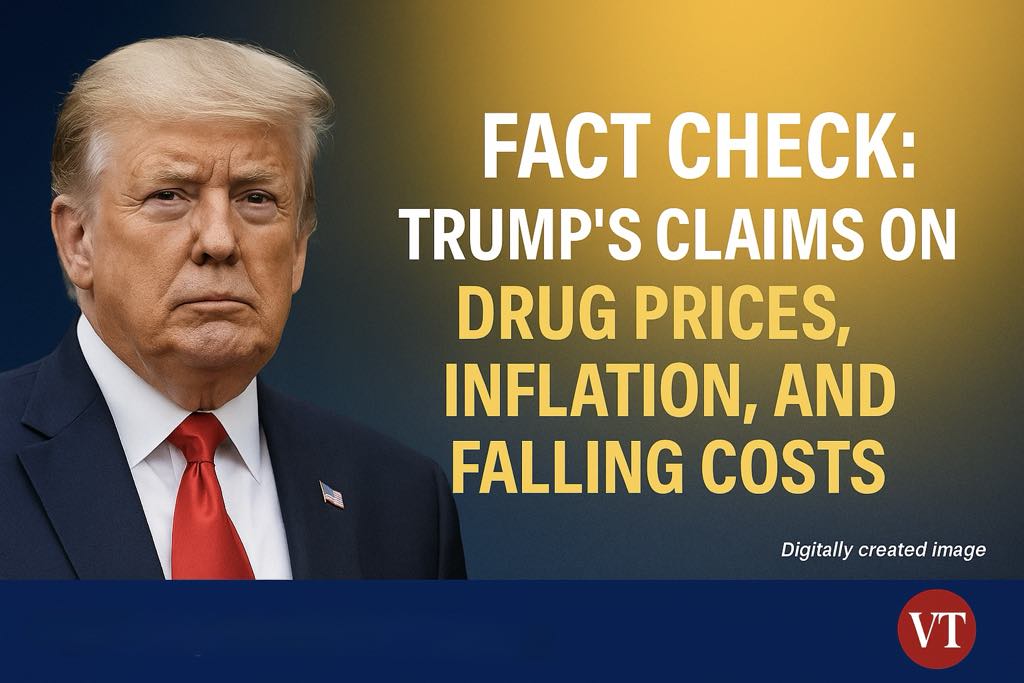“Drug prices down 59%, gasoline and groceries cheaper, and no inflation—LOVE, DJT.” That was President Donald Trump’s latest economic proclamation, made on May 12, 2025, via his Truth Social account Truth Social link. Bold and sweeping, the post aimed to paint a picture of a booming economy under his leadership. But how accurate are these claims? A deeper look into the facts reveals a far more complex economic reality.
Claim 1: “Drug Prices to Be Cut by 59%”
Verdict: Partially True 🔶
Trump’s claim appears rooted in a real policy initiative. On May 11, 2025, he announced plans for an executive order to reduce prescription drug prices by aligning them with prices paid in other wealthy countries. The strategy, known as the “most favored nation” pricing model, aims to ensure that Americans do not pay more than citizens of countries like Canada or Germany.
According to Reuters, as reported by Yahoo News, Trump’s proposed executive action is designed to replicate a similar effort made during his first term. That version, which targeted Medicare Part B drugs, was blocked in court and never took effect. Nonetheless, the new proposal is estimated to reduce prices by 30% to 80%, with the 59% figure being a midpoint estimate frequently cited on social media but not officially documented (Reuters via Yahoo).
The feasibility of this price drop remains uncertain. As noted by LiveMint, the United States still pays among the highest drug prices globally, with a blood thinner like Eliquis costing $606 per month in the U.S., versus $114 in Sweden and $20 in Japan (LiveMint). Aligning prices would require major regulatory shifts and may face legal resistance from pharmaceutical companies, who argue it could reduce innovation or limit access.
Conclusion: Trump’s claim reflects policy intent and plausible savings but lacks transparency and legal certainty at this stage.
Claim 2: “Gasoline, Energy, Groceries, and All Other Costs Are Down”
Verdict: False ❌
Gasoline Prices
Gas prices have indeed dipped compared to 2024 but are not dramatically lower than earlier in 2025. According to the Energy Information Administration (EIA), the average national gas price as of May 6, 2025, was $3.13 per gallon, down from $3.62 a year ago but roughly the same as it was when Trump took office in January (EIA Report).
According to AAA, no state is seeing the sub-$2 gasoline price that Trump has hinted at in prior posts (AAA Gas Prices).
Energy Prices
Some sectors of energy have decreased in price. As reported by The Bureau of Labor Statistics, gasoline prices fell 9.8% over the last 12 months. However, electricity rose by 2.8%, and natural gas prices jumped by 9.4% (BLS CPI March Report). That means the overall energy cost picture is mixed at best.
Grocery Prices
The claim that grocery costs are down is clearly false. According to CNN, food-at-home prices rose by 2.4% between March 2024 and March 2025. Specific categories, such as eggs, skyrocketed more than 60% due to an avian flu outbreak that significantly affected poultry supply (CNN Business).
Other Costs
Consumer prices overall rose by 2.4% year-over-year in March 2025, with categories like rent, insurance, and medical care services contributing to steady increases. According to Bloomberg, apparel and shelter costs continue to rise, contradicting the claim that “all other costs” are falling (Bloomberg).
Conclusion: While some temporary dips occurred, especially in gasoline and select energy categories, the broader trend reflects ongoing cost increases across most sectors, especially groceries and shelter.
Claim 3: “No Inflation”
Verdict: False ❌
Inflation, though lower than its 2022 peak, still exists. The Consumer Price Index (CPI) for March 2025 shows a 12-month increase of 2.4%, according to the Bureau of Labor Statistics (BLS). This is a decrease from February’s 2.8%, but far from “no inflation” (BLS CPI March Report).
Economists warn that new tariffs announced by Trump in April—including a 10% tariff on all imports and up to 60% on Chinese goods—are likely to push inflation higher in the coming months. As reported by Bloomberg, Federal Reserve Chair Jerome Powell has publicly cautioned that such tariffs will raise costs for American consumers (Bloomberg).
Moreover, consumer sentiment reflects inflation concerns. A recent University of Michigan survey reported that expectations for inflation one year from now rose to 3.3% in April, up from 2.9% in March, as cited by MSNBC (MSNBC).
Conclusion: The claim of “no inflation” is objectively false. While inflation is easing, it remains present and could increase further due to new trade policies.
Final Verdict
Trump’s Truth Social statement is a blend of political optimism and economic misrepresentation. His proposed executive action on drug prices could, if implemented and upheld legally, lead to meaningful reductions—but the 59% figure is speculative. Meanwhile, claims that essential costs are broadly down and that inflation has vanished are clearly refuted by government data and economic analysis.
As with many campaign-season claims, context is everything. The economic picture under Trump’s second term is nuanced: some indicators show progress, others reflect volatility or persistent inflation. Cherry-picking favorable statistics to paint a rosy narrative may appeal to supporters but doesn’t align with the full economic picture.
Follow Virginia Times at gnbnow.com for updates and fresh news.
A global media for the latest news, entertainment, music fashion, and more.















